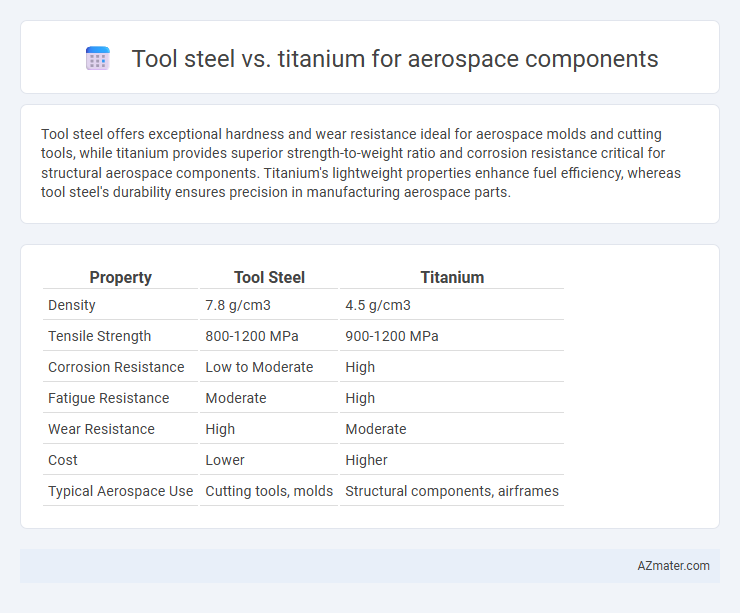Tool steel offers exceptional hardness and wear resistance ideal for aerospace molds and cutting tools, while titanium provides superior strength-to-weight ratio and corrosion resistance critical for structural aerospace components. Titanium's lightweight properties enhance fuel efficiency, whereas tool steel's durability ensures precision in manufacturing aerospace parts.
Table of Comparison
| Property | Tool Steel | Titanium |
|---|---|---|
| Density | 7.8 g/cm3 | 4.5 g/cm3 |
| Tensile Strength | 800-1200 MPa | 900-1200 MPa |
| Corrosion Resistance | Low to Moderate | High |
| Fatigue Resistance | Moderate | High |
| Wear Resistance | High | Moderate |
| Cost | Lower | Higher |
| Typical Aerospace Use | Cutting tools, molds | Structural components, airframes |
Introduction to Aerospace Materials
Tool steel offers exceptional hardness and wear resistance, making it ideal for aerospace components requiring high durability under mechanical stress. Titanium provides a superior strength-to-weight ratio and excellent corrosion resistance, which is critical for lightweight structural aerospace parts exposed to extreme environments. Selecting between tool steel and titanium depends on balancing performance factors such as weight, strength, and environmental resistance in aerospace material applications.
Overview of Tool Steel
Tool steel offers exceptional hardness, wear resistance, and the ability to maintain a sharp edge under high-stress conditions, making it ideal for aerospace components subjected to heavy mechanical loads. It exhibits high tensile strength and excellent thermal conductivity, which ensures durability and performance in fluctuating temperature environments. Compared to titanium, tool steel provides superior machinability and cost-efficiency, though it is heavier and less corrosion-resistant.
Overview of Titanium
Titanium offers an exceptional strength-to-weight ratio and superior corrosion resistance, making it ideal for aerospace components requiring lightweight durability. Its high fracture toughness and ability to withstand extreme temperatures enhance performance in critical aerospace applications. Unlike tool steel, titanium's lower density significantly reduces overall aircraft weight, improving fuel efficiency and operational range.
Mechanical Properties Comparison
Tool steel offers superior hardness and wear resistance, making it ideal for components subjected to high stress and abrasion, while titanium excels in strength-to-weight ratio and corrosion resistance, crucial for aerospace applications requiring lightweight and durable materials. Titanium's high tensile strength ranges from 900 to 1,200 MPa with a low density of 4.5 g/cm3, significantly lighter than tool steel, which has tensile strengths up to 2,500 MPa but a density near 7.8 g/cm3. The elastic modulus of titanium (approximately 110 GPa) allows better flexibility and fatigue resistance compared to tool steel's higher modulus (around 200 GPa), impacting component longevity under cyclic aerospace loading conditions.
Weight and Density Differences
Tool steel exhibits a density of approximately 7.8 g/cm3, significantly heavier than titanium's density of about 4.5 g/cm3, making titanium the preferred choice for aerospace components that demand lightweight materials. The lower density of titanium contributes to improved fuel efficiency and enhanced payload capacity in aerospace applications. Despite tool steel's superior hardness and wear resistance, titanium's combination of high strength-to-weight ratio and corrosion resistance optimizes performance in weight-critical aerospace designs.
Corrosion and Temperature Resistance
Tool steel offers excellent mechanical strength but is prone to corrosion and oxidation at elevated temperatures, limiting its suitability for aerospace components exposed to harsh environments. Titanium exhibits superior corrosion resistance and maintains strength at high temperatures up to 600degC, making it ideal for aerospace applications requiring durability and longevity. The high strength-to-weight ratio and oxidation resistance of titanium provide critical performance advantages over tool steel in aerospace components subjected to extreme conditions.
Machinability and Fabrication
Tool steel offers superior hardness and wear resistance, making it suitable for high-strength aerospace components, but it presents challenges in machinability due to its toughness and tendency to work harden. Titanium excels in machinability with advanced tooling techniques, providing excellent strength-to-weight ratio and corrosion resistance, which is critical for aerospace fabrication processes requiring precision and durability. Fabrication of titanium alloys involves specialized equipment and parameters to control heat and avoid contamination, while tool steel demands slower cutting speeds and frequent tool changes to manage heat and maintain surface integrity.
Cost and Economic Considerations
Tool steel offers a significantly lower cost compared to titanium, making it a more economical choice for aerospace components with less stringent weight requirements. Titanium's high price is justified by its superior strength-to-weight ratio and corrosion resistance, which reduce long-term maintenance and fuel costs in aerospace applications. The initial investment in titanium is balanced by lifecycle savings, while tool steel remains preferred for budget-sensitive projects where performance trade-offs are acceptable.
Typical Aerospace Applications
Tool steel is commonly used in aerospace for manufacturing high-strength molds, dies, and cutting tools due to its excellent hardness and wear resistance, essential for precision component fabrication. Titanium excels in aerospace applications requiring exceptional strength-to-weight ratio, corrosion resistance, and high-temperature performance, such as airframe structures, engine components, and fasteners. Titanium alloys dominate in critical load-bearing components where weight reduction directly impacts fuel efficiency and performance.
Choosing the Right Material for Aerospace Components
Tool steel offers exceptional hardness and wear resistance, making it ideal for high-stress aerospace components requiring durability and precise machining. Titanium excels in aerospace applications due to its superior strength-to-weight ratio, corrosion resistance, and ability to withstand extreme temperatures. Selecting the right material involves balancing mechanical performance, weight constraints, and environmental resistance to optimize component efficiency and longevity.

Infographic: Tool steel vs Titanium for Aerospace component
 azmater.com
azmater.com